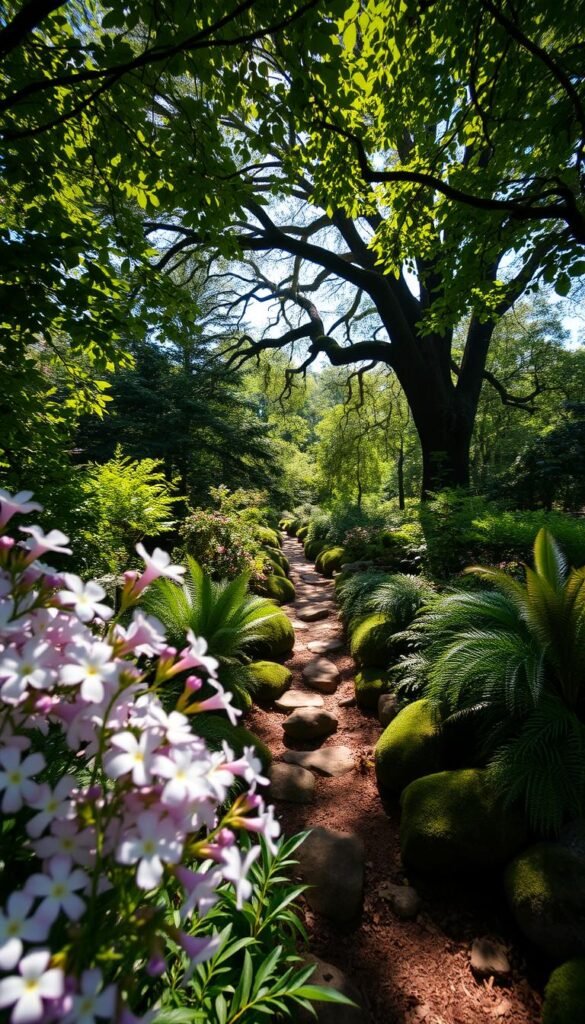Many gardeners think dim corners spell doom for colorful blooms. But here’s a secret: areas with filtered light hold magic for unique plants that sun-baked spots can’t support. Imagine delicate petals glowing under tree canopies or vibrant foliage dancing in gentle rays—that’s the charm of working with nature’s soft-lit stages.
“The right selections turn challenges into triumphs,” notes landscape designer Rebecca Sweet. Unlike sun-loving varieties, these species revel in cooler conditions, offering textures and hues that flourish where others fade. From velvety hostas to airy astilbes, your space can burst with life without direct sunlight.
You’ll find joy in discovering how layered plantings create depth where light is scarce. Proper soil prep and moisture management become your best tools, letting roots thrive while preventing competition from thirsty trees. This approach transforms overlooked nooks into eye-catching retreats that bloom spring through fall.
Ready to rethink those shadowy patches? What starts as a problem area could become your favorite garden feature—a living tapestry that changes with the sun’s gentle movements. Let’s explore how to harness dappled light’s potential, creating spaces where beauty unfolds in subtle, surprising ways.
Understanding Shade and Its Challenges
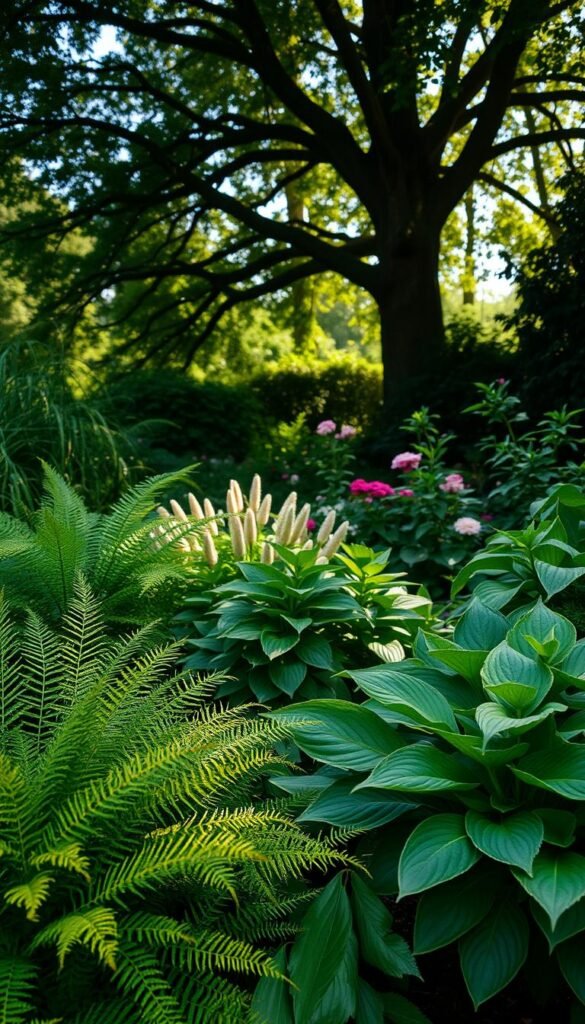
Unlock the secrets of your garden’s shadowy corners with the right knowledge. While these spots might seem limited at first glance, they offer distinct advantages for specific plants. The key lies in decoding your space’s light patterns and moisture levels.
Three Light Categories Explained
Not all shaded areas are created equal. Full shade zones receive less than 3 hours of direct sunlight—perfect for mosses and certain ferns. Partial shade spaces enjoy 3-6 hours of gentle rays, often in morning patterns. The most dynamic option? Dappled light creates ever-changing patterns under tree canopies.
| Light Type | Sun Exposure | Best For |
|---|---|---|
| Full Shade | Hostas, Ferns | |
| Partial Shade | 3-6 hours | Astilbe, Hydrangeas |
| Dappled | Filtered light | Bleeding Hearts, Trillium |
Mapping Your Space
Track sunlight patterns through seasons using simple tools: a notebook and hourly checks. Notice how structures or trees create microclimates. For container solutions in tricky spots, explore shade-loving container plants that adapt to changing conditions.
Remember: morning sun with afternoon protection often works better than harsh midday rays. Your observations will reveal which areas need moisture-loving plants versus those that handle drier soil.
Selecting the Right Shade-Loving Plants
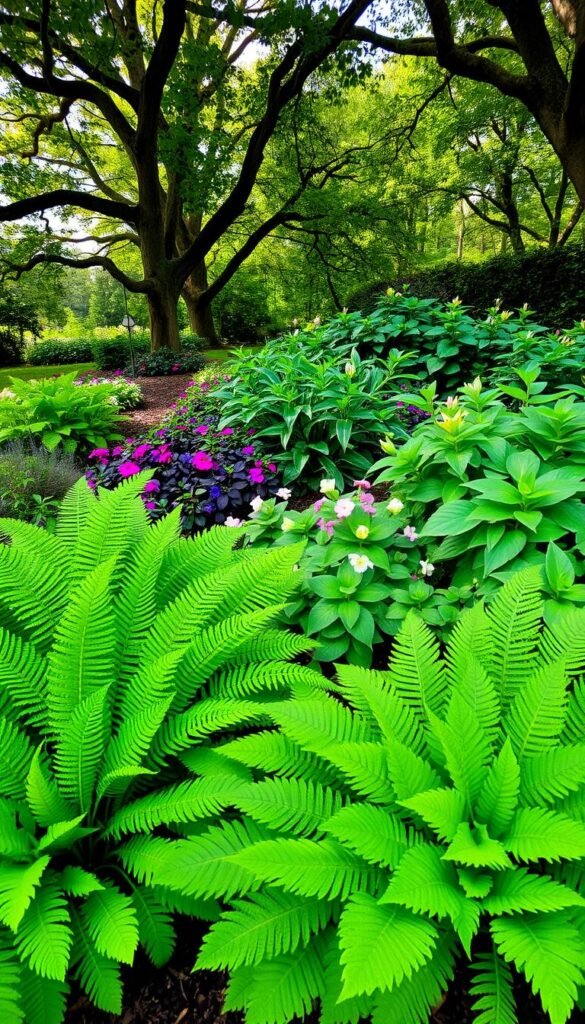
Discovering the perfect plants for shaded areas feels like solving nature’s puzzle. These species have clever adaptations that let them flourish where others struggle. Look for varieties with broad, thin leaves that act like solar panels in low-light settings.
Key Characteristics of Shade Plants
Species suited for filtered light often showcase larger foliage to capture sunlight efficiently. Their leaves tend to be thinner than sun-loving varieties, allowing better light penetration. You’ll notice slower growth patterns too—these plants conserve energy instead of racing upward.
Many shade-loving options feature silver markings or variegated patterns. These natural highlights help reflect available light. “It’s like they’ve built-in flashlights,” says horticulturist Linda Chalker-Scott about their adaptive foliage.
Tips for Matching Plants to Your Garden’s Light
Start by decoding nursery labels. Terms like “partial shade” mean 3-6 hours of morning sun. Test your space by observing shadows hourly—some spots get more light than you think.
Pair plants with similar needs. Impatiens work well under maples where roots compete for moisture. Caladiums thrive where humidity lingers. Remember: even shade-loving varieties need some filtered light to photosynthesize effectively.
Create contrast using different leaf shapes and heights. Combine feathery astilbes with bold hostas for visual drama. This layered approach mimics natural forest floors where multiple species coexist beautifully.
Planning a Shade Flower Garden: Varieties That Thrive in Dappled Light
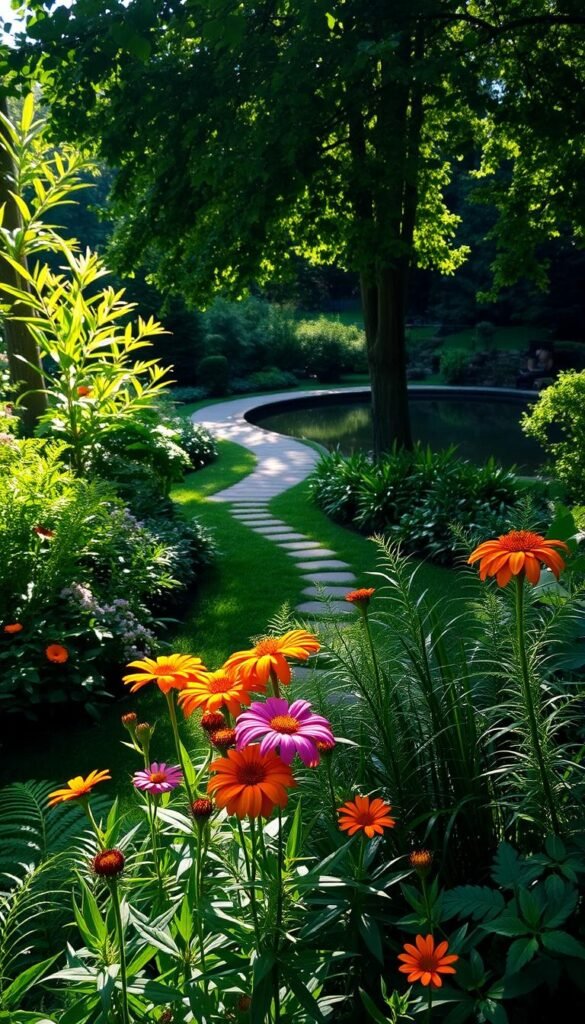
Those shadowy corners you’ve been ignoring? They’re prime real estate for nature’s most elegant performers. By combining strategic plant choices with smart design, you’ll create living mosaics that shift with the sun’s filtered rays.
Start by grouping plants in three tiers for depth. Low-growing blooms like foamflower form a carpet, while mid-height columbines add vertical interest. Taller specimens like foxgloves create dramatic backdrops. This layering technique mimics natural woodland ecosystems.
| Plant | Bloom Period | Color Range |
|---|---|---|
| Bleeding Heart | Spring-Early Summer | Pink, White |
| Columbine | Late Spring | Bi-colors |
| Toad Lily | Fall | Speckled Purples |
| Lungwort | Spring | Blue, Pink |
Rotate seasonal stars to maintain year-round appeal. Early bloomers like trillium give way to summer-blooming best shade-tolerant flowers, followed by autumn’s jewel-toned cyclamen. “This staggered approach keeps the show running,” advises garden designer Emily Henderson.
Create winding paths using moss stones to invite exploration. Position benches where morning light filters through tree branches. Your once-overlooked space becomes a dynamic theater where leaves and petals play with shifting light patterns.
Exploring Iconic Plants for Shaded Landscapes
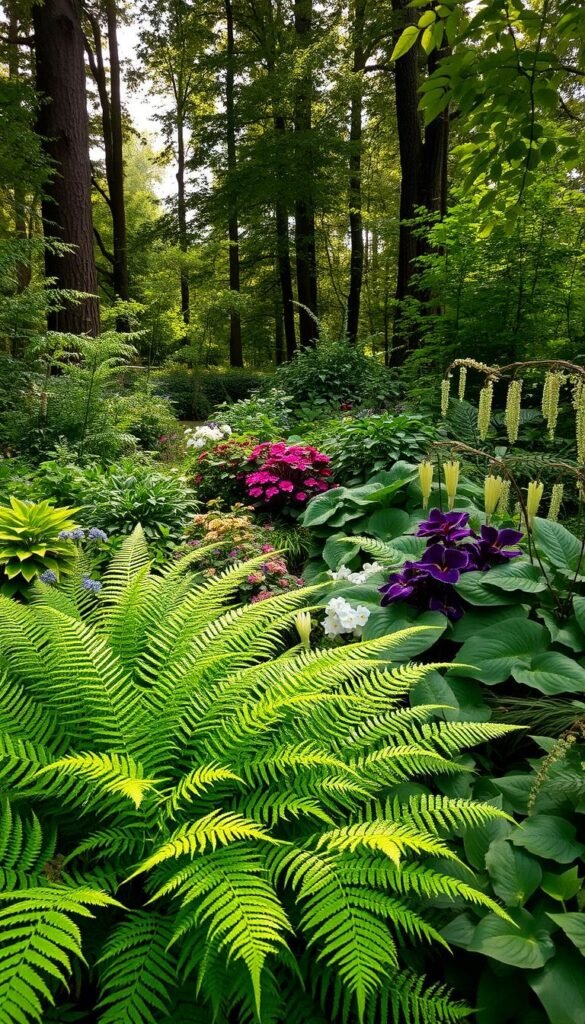
Your shaded garden deserves star performers that elevate its beauty effortlessly. These six botanical treasures bring drama and elegance to dim corners through their distinctive forms and seasonal surprises.
Hostas, Bleeding Hearts, and Japanese Painted Ferns
Hostas reign supreme with their sculptural leaves, offering textures from crinkled to smooth. The Shadowland® ‘Autumn Frost’ variety shines with blue-green centers and golden edges. Pair them with ‘Pink Diamonds’ bleeding hearts, whose heart-shaped blooms sway like nature’s jewelry on arching stems.
Japanese painted ferns add artistic flair. The ‘Crested Surf’ variety displays silver fronds with purple veins, resembling brushed watercolor paintings. These three create a textural symphony perfect for woodland settings.
Coral Bells, Astilbe, and Foamflower Highlights
Dolce® ‘Wildberry’ coral bells explode with burgundy foliage that deepens in color through summer. Their vibrant leaves contrast beautifully with ‘Dark Side of the Moon’ astilbe’s feathery pink plumes. Both thrive where morning light filters through trees.
Complete your planting with ‘Cutting Edge’ foamflower. This native groundcover offers white spring blossoms and marbled leaves that persist through winter. Together, these plants form a layered display that evolves across seasons.
Pro tip: Combine their varying heights and bloom times. Hostas and ferns provide structure, while coral bells and astilbe deliver pops of color. You’ll create a living tapestry that enchants from first spring shoots to autumn’s final curtain.
Incorporating Color and Texture in Your Shade Garden
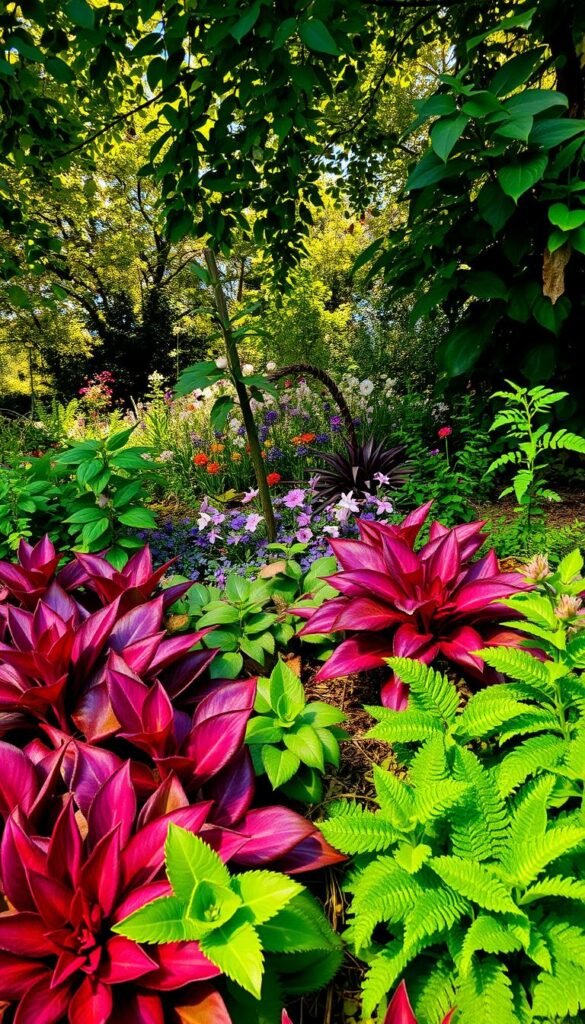
Shaded spaces aren’t limited to green—discover a spectrum of hues that thrive without full sun. While blooms come and go, colorful foliage delivers lasting drama from spring until frost. This approach lets you craft eye-catching displays that evolve through seasons.
Using Vibrant Foliage and Unique Blooms
ColorBlaze® Dipt in Wine coleus steals the show with wine-red leaves edged in lime. Pair it with Heart to Heart® ‘Blushing Bride’ caladium, whose pink-veined leaves brighten deep corners. “These plants are nature’s stained-glass windows,” says grower Karen Chapman, “reflecting light even in shadowy spots.”
Polka dot plants add playful energy with confetti-like speckles on pink or white leaves. For texture contrast, layer feathery astilbes beside broad hosta leaves. Try mixing heuchera’s ruffled edges with Japanese forest grass’s flowing blades.
Want mobile color? Use these stars in colorful container arrangements near seating areas. Variegated plants like ‘Snow Angel’ heuchera mimic dappled sunlight, making narrow spaces feel airier. Remember: glossy leaves reflect light, while matte finishes absorb it—combine both for depth.
Pro tip: Chartreuse or silver foliage acts like natural spotlights. Position these near dark evergreens for striking contrasts. Your garden will prove shadows aren’t limitations—they’re opportunities for creativity.
Seasonal Considerations for Shade Garden Design
A shade garden’s beauty can evolve through every season with the right plant lineup. By understanding growth cycles and light shifts, you craft spaces that captivate from first thaw to winter’s rest. Strategic choices keep your retreat vibrant even as tree canopies thicken and temperatures rise.
Early Summer Blooms and Late Spring Foliage
As late spring transitions to early summer, astilbe becomes a star performer. Its feathery plumes in pink or white rise above fern-like leaves, filling gaps left by fading bleeding hearts. These heart-shaped blooms dazzle in spring but vanish by June, making room for summer’s bold foliage displays.
Ensuring Year-Round Visual Interest
Start with hellebores for winter-to-spring color, then layer in foamflower’s frothy April blossoms. When summer heat arrives, coral bells’ burgundy leaves and toad lilies’ speckled flowers maintain interest. This staggered approach ensures no bare spots—just shifting textures and hues that dance with filtered light.

